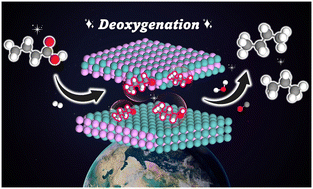DFT insights into crystal plane effects of molybdenum phosphide (MoP) on the catalytic performance in deoxygenation of palmitic acid†
Abstract
Deoxygenation (DX) of bio-oil surrogates via hydrotreating has attracted considerable attention in bio-oil treatment research. This study investigates DX reaction mechanisms of palmitic acid on two distinct molybdenum phosphide (MoP) planes: (001) and (101). Through density functional theory (DFT) calculations, we aim to understand how different crystal planes influence these DX mechanisms. We classified the DX mechanisms on both surfaces into two potential pathways: (i) hydrodeoxygenation (HDO), where oxygen is removed as water, yielding an alkane product with an equal carbon count as the reactant and (ii) decarbonylation (DCO), which eliminates oxygen as CO, producing an alkane product with one fewer carbon atom. Our results reveal that the MoP (101) surface is more active than the MoP (001) surface, making it the optimal surface for DX reactions. The DX reaction mechanism on the MoP (101) surface also shows a preference for the HDO pathway over the DCO pathway (1.43 vs. 2.93 eV). The activation energy (Ea) for the HDO pathway on the MoP (101) surface is lower than that on the MoP (001) surface (1.43 vs. 1.64 eV), due to different hydrogen atom adsorption sites on both surfaces. Kinetic studies show that the reaction rate for both pathways increases with temperature on both surfaces. These findings align with experimental data indicating that the HDO reaction over MoP is more feasible than the DCO pathway. Our research significantly contributes to our understanding of DX reactions over MoP catalysts.



 Please wait while we load your content...
Please wait while we load your content...